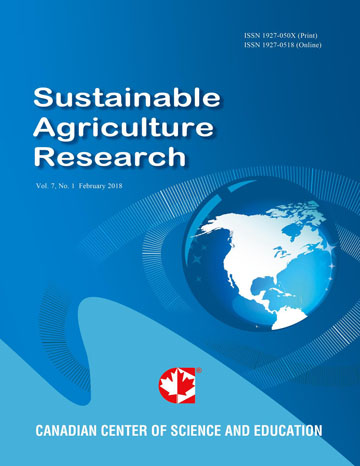Effect of Cropping System and Nitrogen on Maize and Soy Bean Yields in Western Kenya
- P. O. Mongare
- J. R. Okalebo
- C. O. Othieno
- J. O. Ochuodho
- R. Njoroge
- A. N. Otinga
Abstract
Low fertility in highly weathered and degraded soils largely accounts for poor and unsustainable crop yields in most African countries. Studies further reveal negative nutrient balances in major soil elements such as nitrogen (N) (> 46 kg ha-1) and phosphorus (P) (>3 kg ha-1) in most countries in sub-Saharan Africa (SSA), with average mining of the former in some parts of western Kenya estimated at up to 112 kg N ha-1. Productivity of maize and soybean in Kenya, particularly in the western region is generally low, even with application of N, P and potassium (K) fertilizers. The high cost of inorganic fertilizers and decreasing soil productivity demands a reassessment of their use, vis-a-vis, other alternative soil nutrient replenishing technologies. An on-farm experiment was laid down in Bungoma-South, Vihiga, and Teso-North Sub Counties of Bungoma, Vihiga and Busia Counties, respectively of western Kenya to assess the effect of selected cropping systems, N fertilizer and manure on maize and soybean yields. The experiment followed a split-plot design with two factors (cropping systems as the main factor and fertilizer interventions as the sub factor) arranged in a randomized complete block design (RCBD) with three replications. The cropping systems consisted of conventional- that is of maize & soybean intercrop of alternate single rows of each crop, MBILI- planted with maize & soybean intercrop of alternate double rows of each crop- and maize and soybean monocrops. The fertilizer interventions comprised of calcium ammonium nitrate (CAN) and farmyard manure (FYM), both applied at two rates of 30 kg N ha-1 and 75 kg N ha-1, and without fertilizer (absolute control). The experiment was conducted during two subsequent cropping seasons; short rains between August and December 2011 and long rains occurring between March and August 2012. Results showed that maize yields were significantly larger in both the monocropping (mean yield: 2.0 t ha-1) and MBILI systems (mean yield: 1.8 t ha-1) compared to conventional farming (mean yield: 1.3 t ha-1). For soybeans, significantly larger yields were recorded in the monocropping system (1 t ha-1) compared to the MBILI (0.8 t ha-1) and conventional (0.6 t ha-1) systems. Cropping without fertilizer application resulted to low yields at an average of 1.0 and 0.7 t ha-1 for maize and soybean, respectively. Application of CAN at 30 kg ha-1 resulted to an average maize yield of 2.5, 1.4 and 0.7 t ha-1 in Bungoma-South, Vihiga and Teso-North Sub Counties, respectively. At least maize yields increased when FYM was applied at 30 kg ha-1 by 8 and 14% in Bungoma-South, and Vihiga Sub Counties, respectively, above the yield obtained when CAN was applied at 30 kg ha-1. Application of FYM at 30 kg ha-1 resulted to similar maize yield as those observed when CAN was applied at the same rate in Teso-North sub county. For Soybean crop, application of either CAN or FYM at 30 kg ha-1 gave very low yields in the entire Sub Counties and in both seasons. Only in Vihiga Sub County where an average of 1.1 t ha-1 was obtained while the other two Sub counties had much less yields. On average, application of either CAN or FYM at 75 kg ha-1 increased maize yields by 29% above those observed when the two fertilizers were applied at 30kg ha-1. The same trend was observed with soybeans whose yields increased at an average of 26% when either CAN or FYM was applied 75 kg ha-1. The mean Land Equivalent Ratio (LER) values were greater than 1.0 for the intercropping systems and 1.0 for the monocropping system indicating a yield advantage in intercropping over monocropping.
 PDF
PDF
